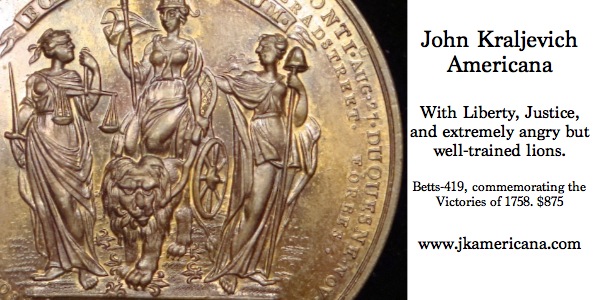
PREV ARTICLE
NEXT ARTICLE
FULL ISSUE
PREV FULL ISSUE
LEAD COUNTERFEITS, MAGNETS AND MAKING ELECTROTYPESPaul Schultz calls out a numismatic error in a newspaper article quoted in last week's issue of The E-Sylum. He writes: A little problem with the story on the London counterfeiters. Lead is not magnetic, even though the article states that the coins are lead and are magnetic. Somebody got it wrong in the original article. Furthermore, the painted coins would probably not have the proper electrical conductivity or other properties either. By the way, electrotype creation is a form of plating, and the art/science of plating is usually underestimated by most who have never dealt with it. The common perception is you take a few items, throw them in a bucket of chemicals with an electric current applied, and a few hours later you get a perfect smooth coating. Nothing could be further from the truth, which is why people have spent decades developing chemical formulas and procedures for plating. I spent a large part of my professional career in plating, but I would hesitate to publish the extensive details necessary to make electrotypes. Although the electrotypes themselves are rather easy to detect as copies, a nearly identical plating process can be used to make counterfeit dies from original coins, and those dies can then be used to strike pretty good counterfeits. Although the concept is simple, the devil is in the details.
Thanks. Definitely a "don't try this at home, folks" activity. Dick Johnson also chimed in on electrotypes, and below is his response to our web site visitor. Thanks!
-Editor
Dick writes: In answer to our reader's inquiry in last week's E-Sylum I sent him this data. Electroforming is the same technology as electroplating. My knowledge of electroforming and electrotypes came from the commercial application in the plants of Medallic Art Company. We made copper electrocasts of artist plaster models. From these artist 's models we made copper shells which would be placed on a Janvier reducing machine. Not only would it reduce the design it would cut a die from the relief on the copper shell. with great fidelity. The copper shells were made in tanks large enough to accommodate models up to 18 inches in diameter. In addition to the copper tanks we also had separate smaller tanks for silver and gold for plating medals after they were struck. These were smaller because the medals were under six inches. The technology has been written about, There are dozens of books on electroplating. Find one of these. The numismatic monograph on the subject John Kraljevich and I are writing is still in research form. We need more examples -- and photographs -- of electrotypes. (We are interested in electroforms made in America in the 1800s and early 1900s. These includes plaques and art objects, not just coins and medals.) As a suggestion, I am certain there is an electroforming firm in Denver. near where you live Ask them with the concept of writing an article . You could see all this in operation and answer all your questions. You asked about the rod on the back of one electrotype you have. This was to hold on to it as it passed through the various steps in the process. It was removed to make the finished item Any kind of lead or solder is satisfactory as a fill-in between two galvano shells. It has no function other than to make the shell more sturdy, and add weight. Bronze powder must be used. It is pure copper. It must conduct the electric current as well as being the release agent. The surface to be deposited must be completely covered. All other surfaces must be covered with wax as a stop-off. I am unaware of where you can buy bronze powders, perhaps an electroplating supply firm. I don't do any of this work myself. I hire the best professionals in the country. It is, as you learned, a very tricky business and not recommended because of the use of cyanide in the electroplating solution.
To read the earlier E-Sylum articles, see:
LONDON COUNTERFEITERS PAINTED FAKE LEAD COINS
(www.coinbooks.org/esylum_v16n26a23.html)

Wayne Homren, Editor The Numismatic Bibliomania Society is a non-profit organization promoting numismatic literature. See our web site at coinbooks.org. To submit items for publication in The E-Sylum, write to the Editor at this address: whomren@gmail.com To subscribe go to: https://my.binhost.com/lists/listinfo/esylum All Rights Reserved. NBS Home Page Contact the NBS webmaster 
|